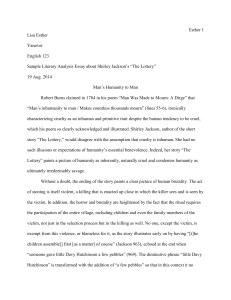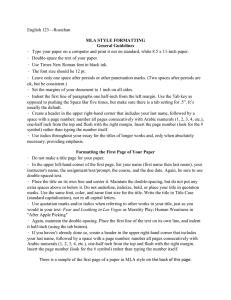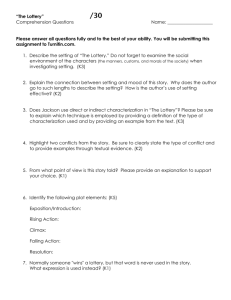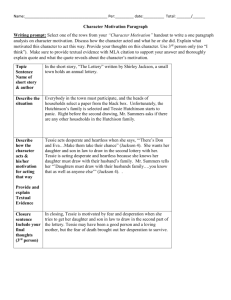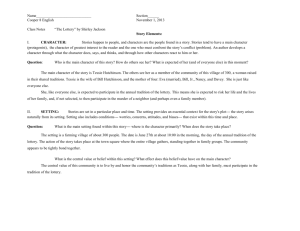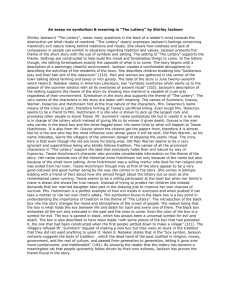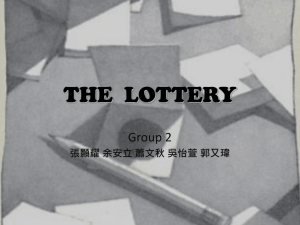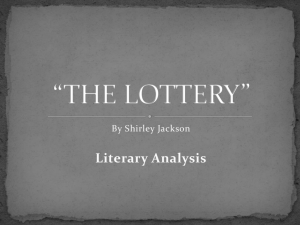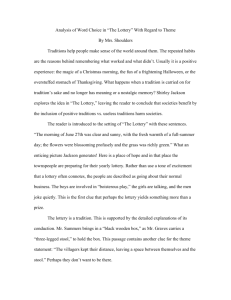View or print the Toulmin Model and Essay Structure Quiz (MS
advertisement
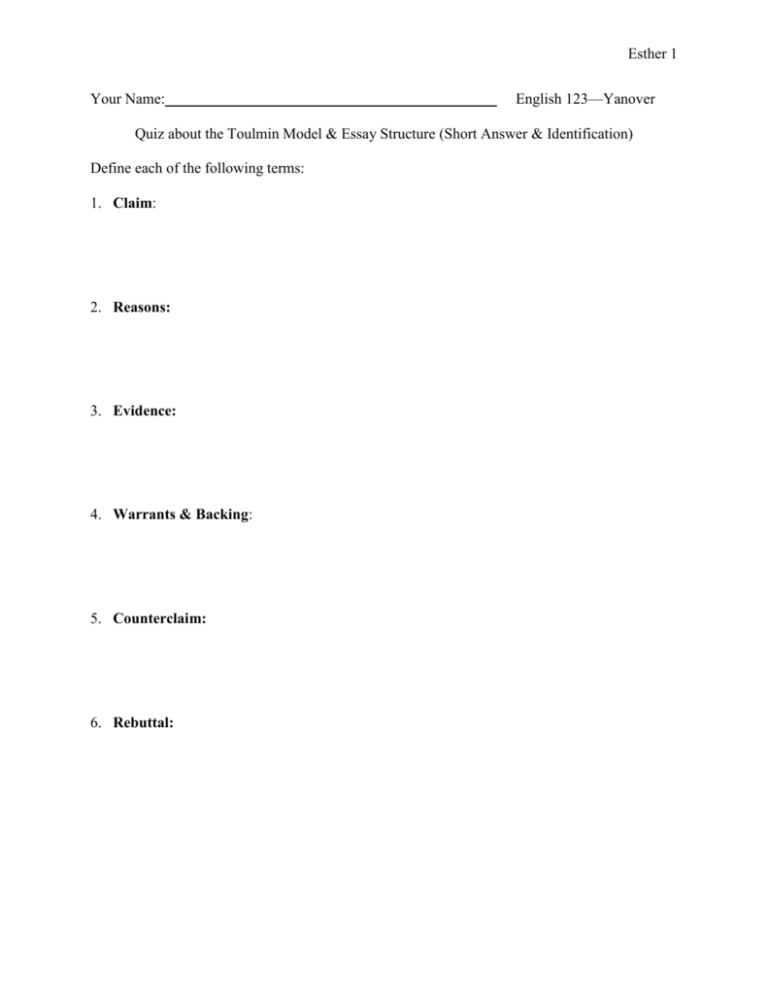
Esther 1 Your Name: English 123—Yanover Quiz about the Toulmin Model & Essay Structure (Short Answer & Identification) Define each of the following terms: 1. Claim: 2. Reasons: 3. Evidence: 4. Warrants & Backing: 5. Counterclaim: 6. Rebuttal: 2 7. Describe the steps in the introductory paragraph. 8. Describe the steps of a body paragraph. 9. Describe the steps in a concluding paragraph. 10. Identify the items below in the sample paper that follows: A. The steps in the introduction B. The steps in one of the body paragraphs C. The steps in the conclusion Esther 1 Lisa Esther Yanover English 123 Sample Literary Analysis Essay about Shirley Jackson’s “The Lottery” 19 Aug. 2014 Man’s Humanity to Man Robert Burns claimed in 1784 in his poem “Man Was Made to Mourn: A Dirge” that “Man’s inhumanity to man / Makes countless thousands mourn” (lines 55-6), ironically characterizing cruelty as an inhuman and primitive trait despite the human tendency to be cruel, which his poem so clearly acknowledged and illustrated. Shirley Jackson, author of the short story “The Lottery,” would disagree with the assumption that cruelty is inhuman. She had no such illusions or expectations of humanity’s essential benevolence. Indeed, her story “The Lottery” paints a picture of humanity as inherently, naturally cruel, a whole town participating in a bloodthirsty and barbaric ritual, violently killing a person who up until her selection had been a valued and loved member of the community. Even the reader doesn’t emerge from the story unscathed, all of humanity ultimately condemned by the story as invariably, irredeemably savage. Without a doubt, the ending of the story paints a clear picture of human brutality. The act of stoning is itself violent, a killing that is enacted up close in which the killer sees and is seen by the victim. In addition, the horror and brutality are heightened by the fact that the ritual requires the participation of the entire village, including children and even the family members of the victim, not just in the selection process but in the killing as well. No one, except the victim, is exempt from this violence, or blameless for it, as the story illustrates early on by having “[t]he 2 children assemble[] first [as a matter] of course” (Jackson 963), echoed at the end when “someone gave little Davy Hutchinson a few pebbles” (969). The diminutive phrase “little Davy Hutchinson” is transformed with the addition of “a few pebbles” so that in this context it no longer evokes innocence but culpability, showing us how the community teaches their traditions to the next generation, thus perpetuating those traditions and making sure everyone is equally guilty. The final image of the story is of the village as a mob, descending on Tessie Hutchinson. Notably absent is any sort of metaphor; the villagers are not compared to beasts or monsters. Instead, they are described simply, straight-forwardly as collectively “remember[ing] to use stones” though other parts of the ritual have been forgotten, urging each other on, making choices that reflect individual abilities and tendencies, such as the number and size of stones to use (639), behaviors that are all inescapably human. The savagery, too, then must be recognized and condemned as human. While the outcome, the stoning of a randomly chosen villager, is horrifyingly cruel, the story reveals that an even more significant and insidious cruelty is the matter-of-fact, efficient politeness all the villagers (with the noted exception of Tessie Hutchinson, the chosen victim, only after her selection) wear like a uniform from the beginning to the end of the ritual sacrifice. The opening paragraph with its matter-of-fact description of the village sets this mood: The morning of June 27th was clear and sunny, with the fresh warmth of a full summer day; the flowers were blossoming profusely and the grass was richly green. The people of the village began to gather in the square, between the post office and the bank, around ten o'clock; . . . in this village, where there were only about three hundred people, the whole lottery took less than two hours, so it could 3 begin at ten o'clock in the morning and still be through in time to allow the villagers to get home for noon dinner. (Jackson 963) It’s a pleasant day; the weather cooperates as do the villagers, who gather at the agreed upon time in the agreed upon place. In subsequent paragraphs, we see them politely, “good humoredly” (965) greeting each other, making small talk, waiting patiently, and following procedure as instructed and expected. Even Tessie Hutchinson, who, ironically, comes late, is, nevertheless, on time for the ritual itself and in good humor; Mr. Summers only just before she arrived had “left off talking and turned to the assembled villagers, . . . cheerfully” (965) greeting her upon her arrival. Tessie, in turn, responds light-heartedly with a joke: “Wouldn’t have me leave m’dishes in the sink, now, would you, Joe?” (965). By the end of the story, the irony and horror of this joke become apparent; Tessie’s final act to tidy her house is itself an act of politeness, one which she did readily without protest or questioning, as if knowing she would not return and not wanting to leave her house a mess. This lesser duty is an ironic foreshadowing of the final one she fulfills, albeit unwillingly, by being sacrificed. The story too proceeds in a mannerly way. With Tessie’s entrance, the story shifts from long paragraphs of description to dialogue, and the pacing picks up, the ritual moving more and more rapidly and efficiently toward its inevitable horrific conclusion, the story politely adhering to its own imperative, doing what a story must do: introduce, act out, and resolve conflict. “[A]nd then they were upon her” (969), the last line of the story announces, abruptly renouncing the former politeness and proper order of the ritual and the story and implicitly condemning them for having led to this barbarity as if it were the only outcome possible. Shirley Jackson’s story’s cynical and unapologetic portrait of humanity as irrevocably savage is deeply disturbing. The horror it confronts us with may be a fiction, but that doesn’t 4 negate its truth, especially the potential to recognize ourselves in the villagers. Haven’t we individually and collectively faced situations when we have been silent in the face of injustice, when we have clung to traditions that allowed the perpetuation of injustice, when we have chosen to protect ourselves and preserve our wellbeing by sacrificing other people and their wellbeing, sometimes without question or hesitation? When it comes down to it, their humanity is ours. If Tessie Hutchinson’s final outcry is an ironic protest against the human tendency to allow and perpetuate brutality, meant for us to hear as Jackson’s appeal to us, there seems to be little expectation that we will, in fact, hear it.
